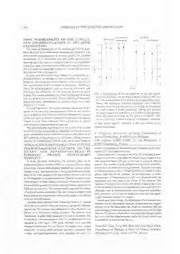
Ionic permeability of the cuticle and ionoregulation in decapod crustaceans PDF
Preview Ionic permeability of the cuticle and ionoregulation in decapod crustaceans
MEMOIRS OF THE QLIEENSLAND MUSEUM 8 NEPHROPS CANGER IONIC PERMEABILITY OF THE CUTICLE ASTACUS HOMARUS: MAIA CARCINUS AND TONOREGULATION IN DECAPOD (up te tL) 5 CRUSTACEANS -2 1 > 8i " ] <* The janic permeabilities of the isolated gill cuticle have been deduced from diffusional transculicular potential and -s } e | 474 conductance meusurements. in several species of decapod crustaceans. I) is established that the Gulicle permeability depends upon the species considered and its ionoregulation capability, upon the localisation of the gill (nthe gill chamber a Otrh e evneant uruep oonf tthhee tioonpiocg rsappehciices .r egion in a single gill and upon a5o -5 7 7 ia In each case the cuticle must always be considered as a diffusion harrier for the main osmotic effectors, Na9 and C} , +8 4 4 j * However, the efficiency of this barrier is low in (he case of the sienohaling osmoconformers, Humurus, Nephraps, of] oO Xn <7 Maia. In hyperregulators such as Astacus, Eriached and @ not Carcinus, the efficiency of the cuticular barrier ts much FIG, |, Comparison of the permeability of the gill cuticle higher, The cuticle permeability of the crayfish gill lamina is from six crustaceans to the main osmotic effectors Na9 and Jow tor all jonie species but CY. In the crayfish vill filaments Cl, The permeabiliry (P) is plotted on a logarithmic scale, and in crab gills, permeubility to cations is high. but perme- Notice the difference between regulators and osmocon- ability to Cl is low, formers etiher within the macrura or within the brachyura In hyperreguiators, the cuticle exhibils important differ- (L = gill lamina; F = gill filaments). Taking into account ences in its electrical characteristics between the vanaus the electroneutrality condition, the following salt permea- pairs of pills or even between different topographic regions bility sequence-as related to the species would be : Ho- of the same gill. Wtshows in addition a tunctional asymmetry marus, Nephraps > Mata > Cancer > Carcinus > Astacns. Which favours jonic influxés. This asymmetry is almost of ions across specific channels af the sites where active nonexistent in osmoconforming species. The physiological significance of the cuticle is discussed uplike lakes place. in relation to the jonoregulation capability of the species and more particularly to the subcuticulur spaces described in al! A. Péqueux, University af Liége, Laboratary of Animal Physiology, B-4020 Liége, Belgium. gill epithelia of hyperregulatory Crustacea facing reduced salinity, It is propounded thal the will cuticle contributes to JM. Lignon, LERP, CNRS, 23, rue Becquerel, F reduce ionic leaks in repulatars and yel allows forthe entry 67087 Strasbourg, France. NEUROENDOCRINE CONTROL OF THE weeks for histological observation and biochemical determi- OVARY AND HEPATOPANCREAS IN nation (UV spectrophotometry). SIBERIAN PRAWN, EXOPALAEMON Gonad index was increased more than 2% in ablated prawns MODESTUS compared with 0% forthe controls. Mean oocyte diameter was In many decapod crustaceans, the eyestalks have an X- also increased from 128 um to 850 jum in oyestulk ablated otpan-stnus gland complex (XSC) as a neuroendocrine organ prawns, The number of yolk granules in oocytes was markedly controlling various physiological phenomena such as colour preaterin eyestalkless than in intact prawns. The pyknotic index change, moult, reproduction ete: Among the hormones syathe- of hepatopancreas cells of ablated prawns was about 3 times sived in the XSC, gona inhibiting hormone (GIH} is involved. greater than that of the controls, At the same me, & looser in the regulation of gonad maturation, Despite studies of eye- arrangement of hepatopancreas cells was observed after the stalk ablation in many species, the source of nutrients required operations than thaliseen in the lissue of the controls. The contenty of total proteins, lipids and carbohydrates in the ovary for precocious gonad maturation, and the primary action site of of the destalked animals were significantly increased (P<0.05) GITH are not yet clear, The present study examined the effects although those in hepatopancreas were decreased coinciden- of eyestalk factors, especially GIH, on ovarian maturation and tally. However, the content of rihonucleic acid was not signil- hepalopancreatic metabolism when the eyestalks were ublated ivantly different between two organs, to block the GIH source. Based upon these results, the differences in biochemical con- Animals were collected from freshwater reservoirs, around stituents and the histological changes, demonstrate that organic the Scosun area on the west side of Korea, during the hibernat- reserves from the hepalopancreas might be mobilised into the ing season. The prawns were transported to the laboratory and ovary during ovarian maturation induced precociously hy cyestalk placed in w crustacean rearing chamber, The prawns were ablation. The present results show that metabolic changes within maintained in glass tanks equipped with sub-sand filters. The the ovary and the hepatopancreas might be closely related and temperature was maintained at 25+1°C and pholo-period was controlled by neuroendocrine factors. adjusted to 12hr light : 12ht dark. Animals were fed with chopped mussel and fish ad libitum. Eyestalks were ablated Yong-Dal Yoon, tong Min Kim and Eun Byun Chun, bilaterally by using small scissors and then cauterised. The Department of Biology, College of Natural Sciences, ovaries and hepatopancreases were dissceted out aficr two Hanyang University, Seoul 133-791, Korea.
